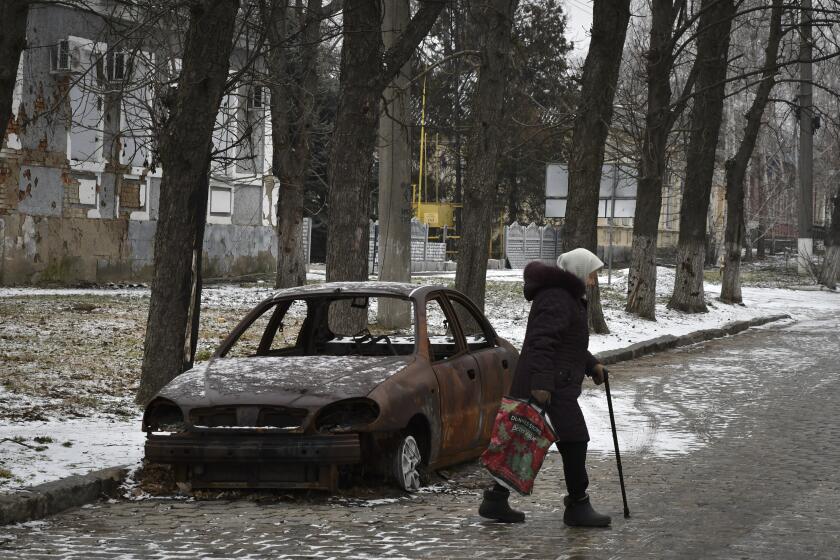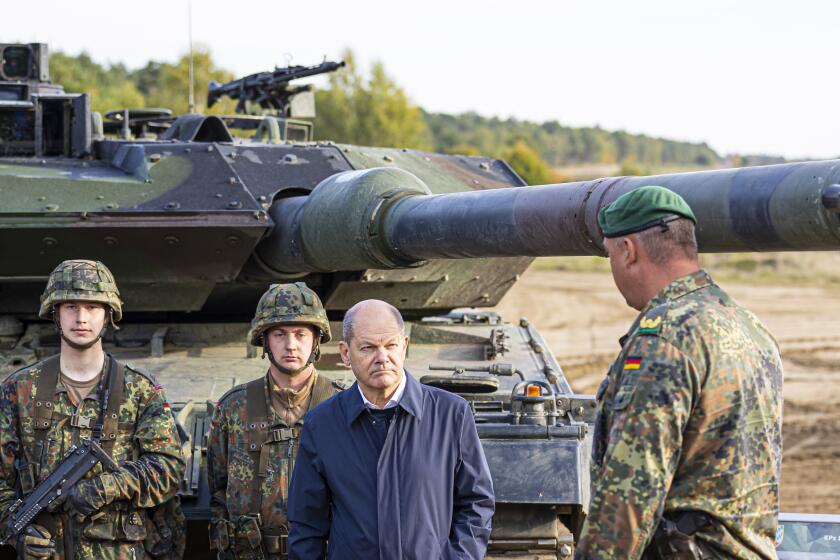U.S. to send Ukraine longer-range bombs in latest turnaround

- Share via
WASHINGTON — After months of agonizing, the U.S. has agreed to send longer-range bombs to Ukraine as it prepares to launch a spring offensive to retake territory Russia captured last year, U.S. officials said Thursday, confirming that the new weapons will have roughly double the range of any other offensive weapon provided by America.
The U.S. will provide ground-launched small diameter bombs as part of a $2.17-billion aid package it is expected to announce Friday, several U.S. officials said. The package also for the first time includes equipment to connect all the different air defense systems Western allies have rushed to the battlefield and integrate them into Kviv’s own air defenses, to help them better defend against Russia’s continued missile attacks.
For months, U.S. officials have hesitated to send longer-range systems to Ukraine out of concern that they would be used to target inside Russia, escalating the conflict and drawing the U.S. deeper in. The longer-range bombs are the latest advanced system, such as Abrams tanks and the Patriot missile defense system, that the U.S. has eventually agreed to provide Ukraine after initially saying no. U.S. officials, though, have continued to reject Ukraine’s requests for fighter jets.
Ukrainian leaders have urgently pressed for longer-range munitions and on Thursday, officials said the U.S. will send an undisclosed number of the ground-launched, small diameter bombs, which have a range of about 95 miles. The officials spoke on condition of anonymity to discuss details of the aid package not yet made public.
To date, the longest-range missile provided by the U.S. is about 50 miles. The funding in the aid package is for longer-term purchases, so it wasn’t clear Thursday how long it will take to get the bombs to the battlefield in Ukraine.
Ukraine’s defense minister Oleskii Reznikov said Thursday the country is prepared to offer guarantees to its Western partners that their weapons won’t be used to strike inside Russian territory, adding that Kyiv needs weapons with the range of up to 186 miles to expel the Russian forces.
The possibility of providing Kyiv with fighter jets to help beat back Russia’s invasion risks the unity of Ukraine’s Western allies.
“If we could strike at a distance of up to 300 kilometers, the Russian army wouldn’t be able to mount a defense and will have to withdraw,” Reznikov said at a meeting with European Union officials. “Ukraine is ready to provide any guarantees that your weapons will not be involved in attacks on the Russian territory. We have enough targets in the occupied areas of Ukraine, and we’re prepared to coordinate on [these] targets with our partners,” the minister said.
The U.S. aid package includes $425 million in ammunition and support equipment that will be pulled from existing Pentagon stockpiles and $1.75 billion in new funding through the Ukraine Security Assistance Initiative, which is used to purchase new weapons from industry.
The Ukraine Security Assistance Initiative, which will pay for the longer-range bombs and the air defense system integration, also funds two HAWK air defense systems, anti-aircraft guns and ammunition, and counter-drone systems.
Germany and the U.S. will send tanks to Ukraine in an effort to help Kyiv break battlefield stalemates as Russia’s invasion enters its 12th month.
Since Russia’s invasion last February, Western allies have pledged a myriad of air defense systems to Ukraine to bolster Kyiv’s own Soviet-made S-300 surface-to-air missile defense systems, and the latest aid package aims to provide the capability to integrate them all, which could improve Ukraine’s ability to protect itself against incoming Russian attacks.
The U.S. has pledged medium- to long-range National Advanced Surface-to-Air Missile Systems, or NASAMS, and truck-launched short-range Avenger air defense systems; the Netherlands, Germany and the U.S. are sending Patriot missile defense systems; Germany is sending medium-range IRIS-T air defense systems; and Spain is sending Aspide anti-aircraft air defense systems.
The longest battle of the war in Ukraine has turned Bakhmut into a ghost city fought over by Ukrainian troops and by Russian forces eager for a win.
The addition of longer-range bombs in the latest aid package was first reported by Reuters.
Ukraine is still seeking F-16 fighter jets, which President Biden has opposed sending since the beginning of the war. Asked Monday if his administration was considering sending F-16 fighter jets to Ukraine, Biden responded, “No.”
On Tuesday, Reznikov was asked if Biden’s ’’no” to F-16s was the final word.
“All types of help first passed through the ‘no’ stage,” Reznikov said. “Which only means ‘no’ at today’s given moment. The second stage is, ‘Let’s talk and study technical possibilities.’ The third stage is, ‘Let’s get your personnel trained.’ And the fourth stage is the transfer [of equipment].”
More to Read
Sign up for Essential California
The most important California stories and recommendations in your inbox every morning.
You may occasionally receive promotional content from the Los Angeles Times.
















